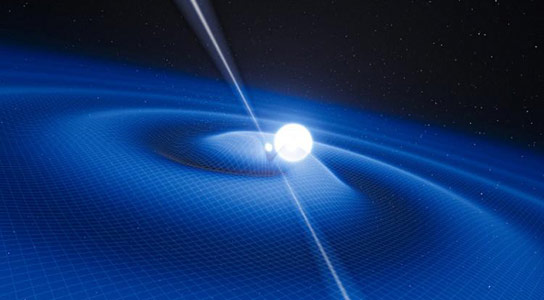
Astronomers from the Harvard-Smithsonian Center for Astrophysics have detected a pair of white dwarf stars that orbit in about 20 minutes and that can be used as a verification source for gravitational wave missions.
Einstein’s general theory of relativity predicts that accelerating masses should radiate gravity waves in a roughly similar way that accelerating electrical charges radiate electromagnetic (light) waves. One notable difference is that the gravitational force is intrinsically about trillion trillion trillion times weaker than the electromagnetic force, and so gravity waves are phenomenally weak. In fact, none has ever been measured in the laboratory, although their presence has been reliably inferred from the decaying orbital energy of binary stars as they radiate these waves into space. Astronomers expect that new generations of gravity wave detectors being built for space will be able not only to test relativity in new regimes, but also measure many important astrophysical phenomena that are otherwise mysterious, from the motion, growth, and evolution of black holes to binary star evolution, and even details of the early universe.
The primary space gravity-wave mission planned is called eLISA (“evolved Laser Interferometer Space Antenna”). It is not scheduled for launch for another decade or more, but a proof-of-concept mission is scheduled for launch in 2015. One of the many issues facing the new gravity-wave instruments is their accurate testing and calibration. White-dwarf binary stars are expected to play this role. When a star like our Sun gets too old, in another seven billion years or so, it will no longer be able to sustain burning its nuclear fuel. With only about half of its mass remaining it will shrink to a fraction of its radius and become a white dwarf star. White dwarfs are common, either isolated or in a multi-star system of some kind, the most famous one being the companion to the brightest star in the sky, Sirius.
Scientists estimate that there are about one hundred million detectable white dwarf stars in binary systems in our galaxy. As they orbit around each other they should emit considerable gravitational radiation. Today, however, only eight confirmed candidates are known. CfA astronomers Warren Brown and Scott Kenyon and four colleagues used the MMT and Gemini telescopes to identify a new member of this select group, a pair of white dwarf stars that orbit each other in only about 20 minutes (recall that the Earth’s orbital period is one year!), making it the second fastest known system. A third star appears to be near them and may be physically related; further observations are needed to resolve this possibility, but if it is part of the system, then the predicted gravity waves from the new triple source will make it one of the strongest prospective emitters of gravity waves.
Reference: “A New Gravitational Wave Verification Source” by Mukremin Kilic, Warren R. Brown, A. Gianninas, J. J. Hermes, Carlos Allende Prieto and S. J. Kenyon, 23 July 2014, MNRAS.
DOI: 10.1093/mnrasl/slu093
arXiv: 1406.3346